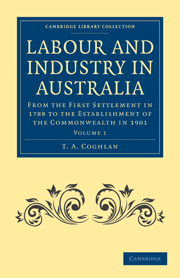 Labour and Industry in Australia
Labour and Industry in Australia Book contents
- Frontmatter
- PREFACE
- Contents
- PART I FROM THE FOUNDATION OF SETTLEMENT TO THE CROSSING OF THE MOUNTAINS
- PART II FROM THE CROSSING OF THE MOUNTAINS TO THE ABOLITION OF THE ASSIGNMENT SYSTEM
- PART III FROM THE ABOLITION OF THE ASSIGNMENT SYSTEM TO THE DISCOVERY OF GOLD
- I INTRODUCTION TO THE THIRD PERIOD
- II TRANSPORTATION
- III IMMIGRATION
- IV LAND LEGISLATION IN NEW SOUTH WALES, VAN DIEMEN'S LAND, AND WESTERN AUSTRALIA
- V LAND LEGISLATION AND SETTLEMENT IN SOUTH AUSTRALIA AND THE WAKEFIELD THEORY OF COLONIZATION
- VI LABOUR AND WAGES
- VII PRICES
- VIII FINANCIAL CRISIS OF 1841, 1842, AND 1843
- IX INDUSTRIES
- PART IV FROM THE DISCOVERY OF GOLD TO THE INTRODUCTION OF FREE SELECTION OF LAND BEFORE SURVEY
- Frontmatter
- PREFACE
- Contents
- PART I FROM THE FOUNDATION OF SETTLEMENT TO THE CROSSING OF THE MOUNTAINS
- PART II FROM THE CROSSING OF THE MOUNTAINS TO THE ABOLITION OF THE ASSIGNMENT SYSTEM
- PART III FROM THE ABOLITION OF THE ASSIGNMENT SYSTEM TO THE DISCOVERY OF GOLD
- I INTRODUCTION TO THE THIRD PERIOD
- II TRANSPORTATION
- III IMMIGRATION
- IV LAND LEGISLATION IN NEW SOUTH WALES, VAN DIEMEN'S LAND, AND WESTERN AUSTRALIA
- V LAND LEGISLATION AND SETTLEMENT IN SOUTH AUSTRALIA AND THE WAKEFIELD THEORY OF COLONIZATION
- VI LABOUR AND WAGES
- VII PRICES
- VIII FINANCIAL CRISIS OF 1841, 1842, AND 1843
- IX INDUSTRIES
- PART IV FROM THE DISCOVERY OF GOLD TO THE INTRODUCTION OF FREE SELECTION OF LAND BEFORE SURVEY
Summary
NEW SOUTH WALES, INCLUDING PORT PHILLIP
During the opening years of the third period, prices were very high in New South Wales, those of all descriptions of agricultural produce having been raised by the severe drought, and those of many imported commodities inflated by speculation. The drought severely affected the farmer, but the pastoralist was even a greater sufferer, as the land in many parts of the colony was absolutely devoid of all sustenance for stock. In October 1838, when it was certain the harvest would fail, the Legislative Council of New South Wales suspended the duty of 5 per cent on imported grain, and in June 1839, when the outlook was still very unsatisfactory, the suspension was continued. It had been anticipated that supplies would arrive from Chili early in 1839, but this relief did not come, and in April wheat was selling in Sydney at 20s. a bushel, and maize at 12s.; hay cost £20 per ton, and fresh butter and vegetables were almost unprocurable. These prices were sustained for a few months, but in July the price of wheat dropped to 13s. a bushel. This amelioration was only temporary, as in the following month the price rose to 30s. a bushel, flour was sold at 75s. to 80s. per 100 lbs., and bread at 2s. 6d. to 2s. 8d. the 4-lb. loaf.
- Type
- Chapter
- Information
- Labour and Industry in AustraliaFrom the First Settlement in 1788 to the Establishment of the Commonwealth in 1901, pp. 460 - 472Publisher: Cambridge University PressPrint publication year: 2011First published in: 1918
